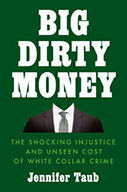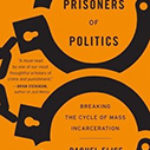Big Dirty Money: The Shocking Injustice And Unseen Cost Of White-Collar Crime

Author: Jennifer Taub
Publisher: New York: Viking, 2020. 298p.
Reviewer: Gregg Barak | February 2021
Legal scholar and advocate Jennifer Taub has authored an erudite and compelling account of the enhanced sanctioning, normalization, and impunity of the crimes of the powerful within the United States. Taub is a fine writer and an excellent story teller. Her historically inclusive narrative is primarily composed in real time and comes across as a running tête-à-tête. Though written for a general audience and not as a textbook, Big Dirty Money could serve as a white collar crime primer for neophytes and scholars alike. Notwithstanding its failure to tackle bourgeois legality and unsustainable capitalist reproduction, this book should be read by anyone with an interest in white collar crime. It provides a wide-ranging gestalt for elite criminality in the U.S. and for its criminal lack of prosecution and punishment.
A twenty-five page preface imaginatively foreshadows, organizes, and sets the table for the 11 well-choreographed chapters to follow. These include: Defining White Collar Crime; Harm Beyond Measure; Corporate Crime Waves and Crackdowns; Victims in the Shadows; Mutually Assured Immunity for the Upper Class; Forgiveness for the Fortunate; Whistleblowers and Journalists; A Contagion of Public Corruption; Suspicious Minds; Tax and Punish; The Six Fixes. To ferret out the arguments advanced and to fully appreciate the history of white collar crime in America, I recommend reading these essay like chapters in sequence, though most of them can stand alone. In this review, I will be sticking almost exclusively to the textual themes articulated in the well constructed preface.
The Preface: The Crime Scene begins by highlighting some high profile crimes of the powerful. Taub reflects on their victimization of the general public and on the financial as well as the human costs or losses involved in “big dirty money.” In the case of the former, she focuses our attention on the looting activities not only of Wells Fargo, one of the most visible banking fraudsters in the USA since the Wall Street implosion, but also on the domain of hedge fund managers and insider trading.
In the case of the latter, Taub focuses our attention on the injuries and deaths caused by a combination of corporate materialism and social indifference. These examples include the 2014 vehicle recall for faulty ignition switches that General Motors had been covering up for twelve years, which was responsible for the killing of at least 124 persons and the injuring of an additional 275; the outrage over OxyContin, Big Pharma, and the 232,000 Americans who died from prescription opioid overdoes between 1999 and 2018; and the 2018 Camp Fire, the most deadly blaze in California history. The fire accounted for the loss of eight-five lives and 18,000 buildings, mostly residential homes. The fire was attributed to Pacific Gas & Electric for paying out some $5 billion in dividends to its shareholders rather than using that money for upgrading its century-old power lines that executives knew all too well could spark fires.
Beyond the financial victimization, physical injuries, and lost lives, Taub addresses the amorphous damages caused by “the top echelon in the business, government, and nonprofit sectors,” emphasizing how their “unpunished and underpunished high-profile criminal offenses” continue to chip away at the rule of law and those institutions that support democracy (p. xiii). The very first sentence of her text proclaims: “Big cheaters often prosper, and they do it right in front of our faces.” The last sentence of the same paragraph reads: “Cheating the public—and getting away with it—is the new normal” (p. ix).
Well, not exactly. Cheating the public may indeed be more visible today than ever before. However, when it comes to the powerful cheating the U.S. public and getting away with it, there is a long history. This type of “corruption” dates back to at least the early 1800s, routinizing itself with the rise of industrialized monopoly capital during the Gilded Age. These emerging repressive bourgeois sociolegal relations, however, do not account for the much longer history of social inequality and sanctioned economic looting in North America. Those “political crimes” began in 17th century colonial America with the various forms and institutions of genocide and slavery, and more recently with the reconstructed post Civil War, Jim Crow legislation, sanctioning both organized discrimination and segregation that was not legally repudiated until the 1960s.
Presently, many more people than ever before are aware of the noncriminal or civil legal realities that surround these big dirty money injustices. Thanks to digital communication and social media, the regulatory settlements of these crimes of the powerful—high profile or otherwise—have certainly become more visible than in the days of analog even with 24/7 news cycles. As a consequence, over the past quarter of a century, harmfully fraudulent activities have been repeatedly outed and demystified to the point that unpunished corporate violations of the law are no longer viewed as exceptions to the rule. For that reason and others, we are no longer only conversing about the deterrence of those rotten apples that spoil the barrels, but we are also talking about the pre-emptive discarding of spoiled barrels or obsolete systems of law and capitalization that require fundamental reorganizing, if we are ever going to realistically deal with these big money crimes.
In other words, developing a consciousness and understanding of the crimes of the powerful are not one and the same with what I have described elsewhere as coming to terms with the financialization of crime and its social control, where conflicts of political and economic interests have always persisted before, during, and after the white collar crime waves and crackdowns—whether these were real or imagined (Barak, 2012). In any case, Taub properly underscores the social reality of normalization in the second paragraph of her text by bringing up presidential pardons granted to those exceptionally powerful and rare criminals who have been either sentenced or burdened with prison:
Just after Valentine’s Day in 2020, President Donald Trump granted
clemency to a slew of affluent felons. Their offenses? Bribery,
investment fraud, tax evasion, Medicare fraud, public corruption,
computer hacking, an extortion cover-up, money laundering,
conspiracy to defraud the federal government, obstruction of justice,
mail fraud, wire fraud (p. ix).
Taub then divides the rest of her preface into six headings: We the Prey; Return to the Crime Scene; Extreme Wealth is Criminogenic; Implicit Impunity; A Path Forward; and The Elephant in the Room.
Under the heading, We the Prey, Taub maintains that these elite criminals victimize us all, directly or indirectly. The biggest take away from this section is that these crimes of the powerful involving mostly frauds of some kind are more costly to society than those crimes of the powerless. Citing the FBI, elite crimes are in fact far more harmful than non white-collar crimes; the former estimated annually to cost victims from $300 to $800 billion, the latter estimated annually to cost a mere $16 billion.
In Return to the Scene of the Crime, Taub revisits the punishments doled out to the many serious offenders identified in the opening to her preface, noting that so far “not a single person has gone to prison.” She wants us to ponder: “How can this be, here in the United States, where we have nearly 2.3 million people incarcerated?” (p. xv). Taub continues by reviewing the alternative or non-punitive legal consequences for each of those high-profile crimes.
In the next two sections of the preface as well as in the rest of the book, without addressing any structural theories that could explain the obvious contradictions in the differences between the punishments of the powerful and the powerless, such as those theories of capital accumulation, debt, regulation, and securitization, Taub relies mostly on unarticulated social-psychological theories of identity, opportunity, status, and deterrence.
In Extreme Wealth is Criminogenic, Taub begins with a dishonorable quotation penned in a letter from Lord Acton to a fellow historian in 1887: “Power tends to corrupt, and absolute power corrupts absolutely.” Next, she conjoins wealth with power:
In our society, extreme wealth often confers tremendous power. So
just as power tends to corrupt, so does excessive wealth. Today we
witness how outsized wealth can be criminogenic. In this way, white
collar crime in particular is a tool with promising possibilities for those
who won’t get caught or punished. When powerful people plunder with
impunity, they grow wealthier. And they can use this wealth to change
laws and their enforcement so that they favor those at the top like
themselves. This is not theory. It’s reality (p. xxiv).
In point of fact, this is praxis. It is also materially relevant to the political-economic theory of crime and inequality and the sociology of criminal law theory in action. With respect to the harms perpetrated and the punishments received, both of these theoretical frameworks can explain the contradictions between the powerful and powerless. By ignoring theories such as these, Taub continues with her agency-driven indictment of the big-money crowd that uses its plundered wealth to:
help ensure that those elected to positions of power in the
government will protect them and further their interests. At the
top of the list is cutting taxes, promoting industries they invest in or
control, and keeping them (and their dear friends and offspring) out
of trouble, out of prison, and in the money. This furthers the wealth
divide in America and undermines notions of fairness and meritocracy,
paving the way for kleptocracy(p. xxiv).
In Implicit Immunity, the political economy of crime theory could also explain the structural “double standard in the American criminal justice system that reflects and perpetuates inequality.” As Taub emphasizes: “Cutting legal corners is a tool for advancement only available to the already affluent. The wealthy not only increase their power by evading punishment, but also benefit from a criminal justice system that incarcerates those with lower social status who also use crime to get ahead”(p. xxvi).
Before turning to the policy fixes in A Path Forward, Taub pays tribute to Edwin Sutherland who “focused his full attention on corporate crime” and “got it right eighty years ago”(p. xxviii). So when “we measure the extent and impact of white collar crime, we need to stop bundling together multimillion-dollar corporate fraud with small-time nickel-and-dime crime like writing bad checks or low-level employee embezzlement.” Taub argues that our concern should be with “the most powerful predators who can literally defraud millions of people for years with impunity”(p. xxix). While this is certainly true. Our primary concern should be with those corporate legal structures that not only enable these powerful predators to victimize us all in the first place, but that also stave off the efficaciousness of the proposed fixes going forward.
Under this heading, Taub introduces six fixes that she elaborates upon in the final chapter of the book. These include: (1) establish a new division within the Justice Department to focus on prosecuting, convicting, and incarcerating big money criminals; (2) empower federal prosecutors by strengthening laws that target bribery of public officials and responsible corporate officers, money laundering, and shell companies; (3) protect victims by establishing a nationwide registry of white collar criminal offenders; (4) expose more corporate crime by funding independent journalists, by banning forced arbitration of workplace disputes, and by expanding our qui tam laws, which have given special standing to whistleblowers to bring legal cases on behalf of the government against corrupt businesses; (5) close loopholes in the tax code and staff up the IRS so it can audit tax evaders and collect billions of dollars of already identified tax receipts; and (6) establish a nationwide database at the Justice Department that tracks the outcomes of all white collar offenses reported to federal agencies. If taken together, Taub maintains that the implementation of these reforms would set us on a path to stopping the spread of the crimes of the powerful while also helping to clean up our public corruption problem.
I agree with these proposals and would like to see them enacted. However, I do not believe that they will materialize in the near future, nor do I think if they did, that they would make a substantial difference in the USA’s political economy of crime and social injustice. Unfortunately, these proposals and others like them are not new. Most have been around since before the 2010 Dodd-Frank Wall Street Reform and Consumer Protection Act. They have yet to gain any legal traction with either of the two major political parties. As Taub indicates, these types of legal reforms have either been disregarded or resisted by Republican and Democratic politicos alike. Accordingly, like other political economists of crime and crime control I continue to argue that the time is well past due to abolish corporate lobbying, political action committees, the Electoral College, and privately funded elections.
Similarly, structural changes in the corporate relations of law, oligarchy, and capitalist reproduction are called for. These types of corporate transformations would address the negative trends that Taub succinctly underscores in chapter 10, Tax and Punish, which continue to keep wealthy looters from any accountability. Without labeling these legal changes as I have, Taub nevertheless identifies them as being at the roots of both public corruption and economic injustice.
Among other economic and social actions that I believe are called for, three of these would include: amending or overturning Citizens v. the United States that Taub also advocates on behalf of; converting those “too big to jail” mega-sized corporations into state-owned enterprises or public utilities (Barak, 2017); and abolishing the corporate person and organization (Whyte, 2015). These latter two fixes are not part of the Taub program of legal reform.
Under the heading, The Elephant in the Room, Taub writes: “One last note. This is not a book expressly about Donald Trump. However, to write about white collar crime and corruption and not mention him would be like discussing the accounting fraud scandals of the 1990s and early 2000s without covering Enron or explaining Ponzi schemes without mentioning Bernie Madoff” (p. xxx).
Of course, when it comes to “big dirty money,” Trump (and The Trump Organization, a group of some 500 business entities) are the consummate law violators without punishment. As a group, they have been credibly accused of having been involved in corporate crime, occupational crime, avocational crime, governmental crime, state-corporate crime, finance crime, enterprise crime, contrepreneurial crime, crimes of globalization, and technocrime. This social reality of impunity also accounts for the fact that Trump and company—their corporate and governmental appointees alike—reappear more than twenty times in the rest of the book as part of Taub’s white collar crime story.
Taub finishes her preface by providing an excellent overview decade by decade of Trump’s “life of crime” from his middle twenties to his early seventies. Putting aside the king of grifters who bamboozled his way into becoming the 45th president of the United States, anyone with an interest in the crimes of the powerful should read Big Dirty Money.
References
Barak, G. (2012). Theft of a Nation: Wall Street Looting and Federal Regulatory
Colluding. Lanham, MD: Rowman & Littlefield.
Barak, G. (2017). Unchecked Corporate Power: Why the Crimes of Multinational
Corporations Are Routinized Away and What We Can Do About It. London and New York: Routledge.
Whyte, D. (2015). The Corporate Criminal: Why Corporations Must Be Abolished.
London and New York: Routledge.
Gregg Barak is an Emeritus Professor of Criminology and Criminal Justice as well as the Co-founding and North American Editor of the Sage Journal of White Collar & Corporate Crime.


